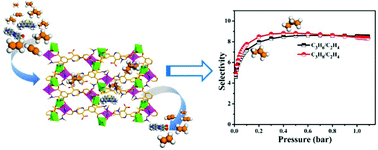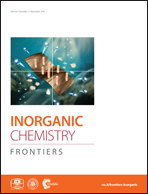An anionic metal–organic framework: metathesis of zinc(ii) with copper(ii) for efficient C3/C2 hydrocarbon and organic dye separation†
Abstract
A novel anionic metal–organic framework (NEM-7-Zn) with constricted pores, which was formed by narrow channels and blocks of functional groups, was constructed under solvothermal conditions. Due to the low stability of the Zn-paddlewheel upon termination of the solvation, NEM-7-Zn possesses a very low surface area. For reinforcing the framework stability, metal-ion metathesis in a single-crystal-to-single-crystal fashion on NEM-7-Zn was performed, and then a new CuII MOF (termed NEM-7-Cu) with an identical framework was produced. Notably, modified NEM-7-Cu possesses constricted pores and is decorated with Lewis basic pyridyl sites and uncoordinated –COO− groups, resulting in high selectivities for C3H6/C2H4 (8.61), C3H6/C2H2 (6.75), C3H8/C2H2 (7.1), and C3H8/C2H4 (8.82) under ambient conditions. Moreover, NEM-7-Cu shows highly selective adsorption of organic dye molecules (MB+ over CV+, RB+, MO−, and SD0) and the adsorbed MB+ can be released in a NaCl-containing CH3OH solution. Such a post-metal-ion metathesis method can be used to synthesize new and desired frameworks that could not be obtained by direct synthesis.



 Please wait while we load your content...
Please wait while we load your content...